Establishing Auckland’s early water supply
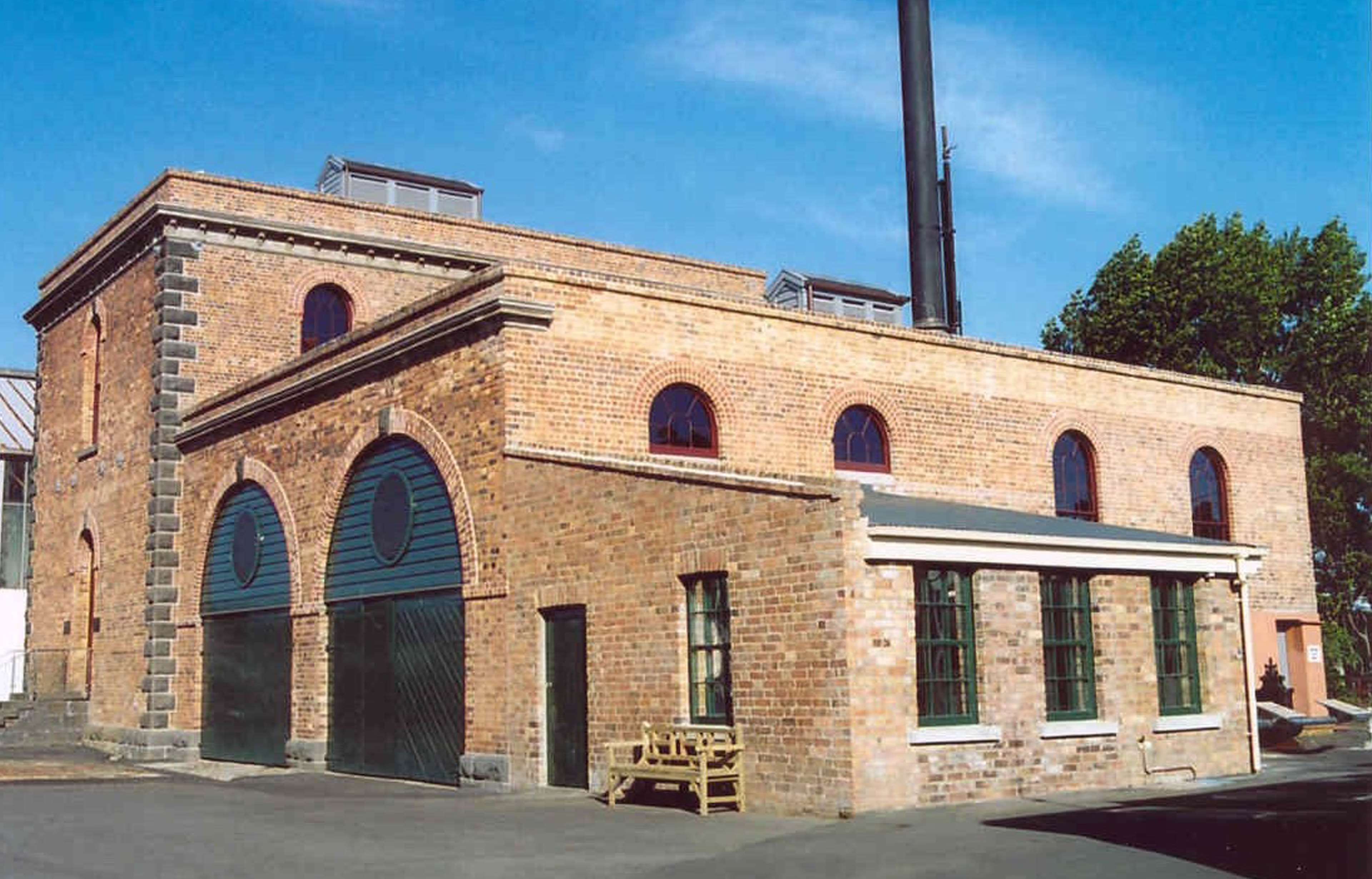

Western Springs Pumping Station [1964.311] Museum of Transport and Technology (MOTAT)
The Western Springs Pumping Station, commonly known as the Pumphouse, was once the centre of Tāmaki Makaurau / Auckland's first large-scale public waterworks. It pumped clean fresh water from Te Wai Ōrea / Western Springs to the rapidly growing city and combatted issues of water shortages, poor water quality, and poverty. At the time of construction, the Auckland Waterworks system was recognised as one of the most advanced public water supply systems in a British colony.
A growing and thirsty city
Auckland city was founded on 18 September 1840. The city’s water supply was initially sourced from rainfall, wells, springs, and streams. As Auckland’s population grew so did its demand for water. The first attempts at a public water supply system began in 1866 when water was piped to the city from the Pukekawa / Auckland Domain springs. However, the growing population of settlers in the city quickly led to water shortages and reduced water quality due to contamination from sewage and industrial waste. After the creation of the Auckland City Council in 1871, it was decided that a public water supply system would be established drawing on the large flow of freshwater emanating from Te Wai Ōrea / Western Springs.

Waiōrea / Motions Creek flowing from Western Springs, circa 1900. Image supplied by Auckland Libraries Heritage Collections, 80-BIN002.
The Auckland Waterworks project
On 7 May 1874 the Council appointed engineer William Errington to design the waterworks system. Errington had become well known for his success in engineering projects across Australia and New Zealand, for example the construction of one of Australia’s first locomotives known as the Lady Barkly, the mining plant at Ballarat goldfields, and the water pump at Thames goldfields. A key challenge for the Auckland Waterworks project was that Te Wai Ōrea / Western Springs lies close to sea level. Errington proposed a pumping station using a steam driven beam engine to lift water to a series of reservoirs at Ponsonby, Khyber Pass Road, and later at Maungawhau / Mount Eden to supply water across the city’s varied landscape. Errington rapidly set to work and by July 1874 had completed plans and specifications that were put out for tender later that year.
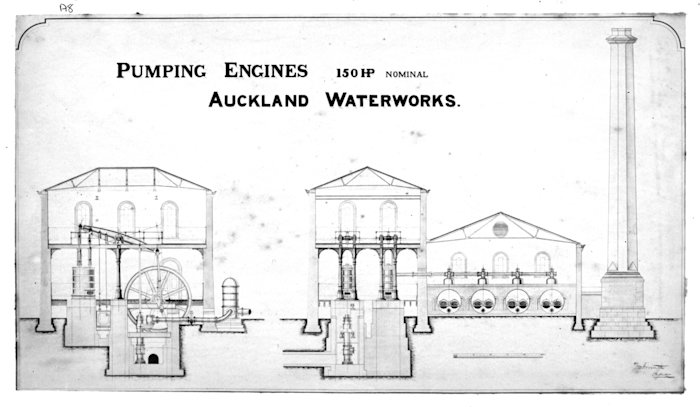
Copy of plans for the Western Springs Pumping Station as part of the Auckland Waterworks. Image supplied by Auckland Libraries Heritage Collections, 7-A12063.
Local Auckland firm T & S Morrin Limited won the tender to construct the reservoirs, machinery, mains, and structures for the Auckland Waterworks. Theirs was the lowest tender at £72,663, which equates to nearly $14 million in 2024 when adjusted for inflation. The tender included £11,000 for the machinery (approximately $2 million in 2024), and £2,000 for the pumping station buildings (approximately $378,000 in 2024).
Construction began in March 1875. By September that year, the 25-foot-deep Engine House suction shaft had been dug, excavations for the building foundations were nearing completion, construction of the dam to create the Western Springs Lake reservoir was well underway, and work was due to start on the 60-foot tunnel connecting the Engine House to the reservoir lake. In terms of the wider water supply system, by January 1876 the earthworks for the receiving reservoirs at Ponsonby and Khyber Pass were complete, with some of the structural elements taking shape at Ponsonby.
Two reservoirs were constructed on the corner of Ponsonby and Karangahape Roads, Ponsonby No.1 in 1877, and Ponsonby No.2 in 1888 (labelled below as the Old Reservoir). When the No.2 reservoir showed signs of weakening around 1907 it was abandoned, and the No.1 reservoir was reinforced. The No.1 reservoir was rebuilt in 1954-5 and is still in use today.
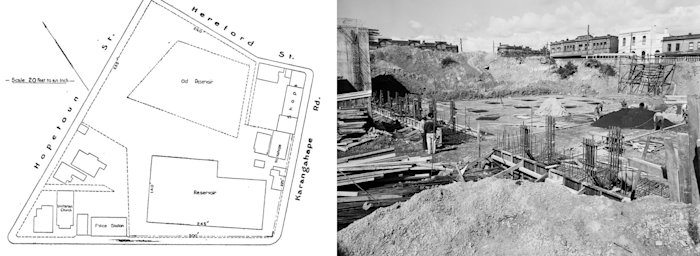
Left: Plan of the Ponsonby reservoir corner, 1927. Image from Auckland Star, (13 June 1927), Volume LVIII, Issue 137, Page 8. Stuff Limited, CC BY-NC-SA 3.0 NZ. Right: Ponsonby Reservoir construction, 1955. Image supplied by Auckland Libraries Heritage Collections, 580-01778, CC BY.
T & S Morrin contracted John Key & Son Limited of Kirkcaldy, Scotland to supply the pumping engine and boilers to Errington’s specifications. The machinery consisted of a double compound condensing steam beam engine, four Lancashire boilers, and two water pumps. The components were manufactured by John Key & Son at their Whitebank foundry in Kirkcaldy, Scotland and shipped to Auckland in six groups arriving between February and August 1876. The Auckland engineering firm Masefield and Company provided the expertise to assemble the components in the pumping station buildings. The Auckland Waterworks was completed on 21 March 1877 and formally opened by the Auckland City Council on 10 July 1877.
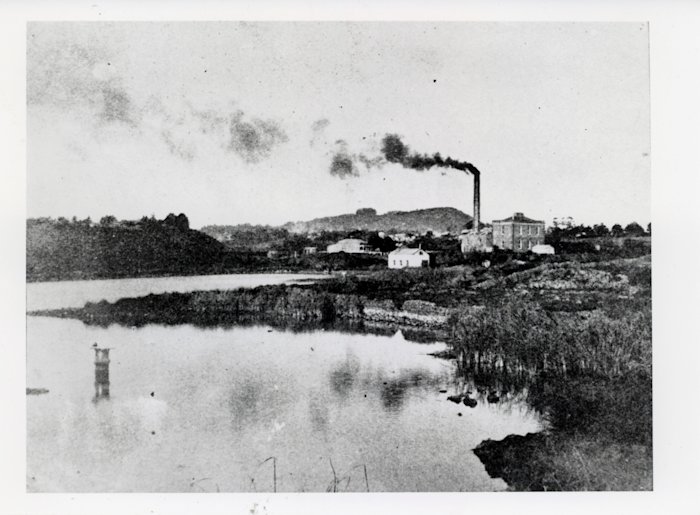
View across the lake to the Western Springs Pumping Station [03-882] Walsh Memorial Library, Museum of Transport and Technology (MOTAT).
Supply and demand
Once the pumping station was up and running, Errington was kept on by the council as the Superintending Engineer to oversee the operation of the waterworks until about 1889. The day-to-day operation of the pumping station was undertaken by an Engineer and a Fireman. The Engineer was tasked with maintaining the plant, while the Fireman stoked the boiler fires and operated the pumping machinery. Two cottages were built to allow the workers to live on-site. The Engineer’s cottage is still on its original site and is also now part of MOTAT, located in Te Pā o MOTAT - MOTAT Village.

The Engineer’s Cottage [2008.24] Museum of Transport and Technology (MOTAT).
After a slow start, connection to and use of the water supply system grew rapidly. This growth in demand led to Errington designing a second reservoir to be constructed at Ponsonby and a new reservoir on Maungawhau / Mount Eden, both completed in January 1888. However, this growth in demand saw the Western Springs Lake level begin to drop from overuse. Supplementary water supplies were sourced from Waititiko / Meola Creek, then known as Edgecombe’s Creek, and the Asylum Springs, on the site of the then Avondale Asylum at Carrington Road. In 1896 a water bore was drilled between the Western Springs Engine House and the lake. A Tangye horizontal duplex compound pumping engine was installed to pump water from the bore reaching below the level of the springs to further supplement the water supply.
By the late 1880s the water quality in the waterworks system was deteriorating. Te Wai Ōrea / Western Springs was believed to have become polluted and further contamination seeped into damaged pipes around the city. Water sourced from Waititiko / Meola Creek also tainted the supply. A further supplementary supply was sourced from the Nihotupu Stream in the Waitākere Ranges and piped to Western Springs. A permanent solution to the supply issue was eventually realised in the construction of several large dams in the Waitākere Ranges. Water supply from the Waitākere Reservoir began in 1907 prior to the completion of the dam in 1910. At the time of construction, Waitākere Reservoir held about 1 billion litres of water, a significant increase from the Western Springs Lake capacity of 100 million litres.
View looking across Waitākere Dam ,1917 [06-659] Walsh Memorial Library, Museum of Transport and Technology (MOTAT)
Decommissioning
In 1914 the Western Springs Pumping Station machinery underwent an overhaul and was subsequently only used in times of shortage or when the Waitākere water supply was interrupted. It was maintained as a reserve pumping station until it was decommissioned in 1936. The last reported use of the pumping station was in 1928.
The original Lancashire boilers were removed and scrapped in 1937. The rest of the machinery, including the beam engine, was also due to be scrapped. However, public interest in the historic machinery halted this with views to retain the site as a museum. The chimney was purchased by Mr E.E. Beale and dismantled in 1948. The bricks were cleaned and reused to construct Beale’s home in Māngere. During the Second World War the components from the ‘A’ engine were broken up for scrap.
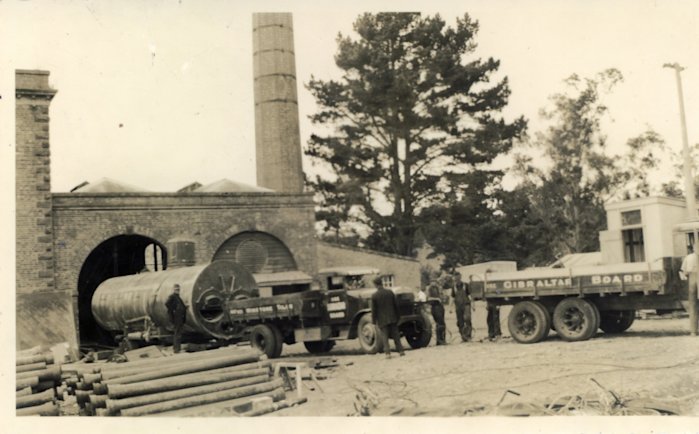
Removal of the Lancashire boilers [03-890] Walsh Memorial Library, Museum of Transport and Technology (MOTAT).
Though the pumping station had been decommissioned, the Waiōrea / Western Springs water supply was drawn on in times of drought, for example in 1943. The water was pumped by a diesel pump and was heavily treated. The pumping station buildings and surrounds were used as a council works depot, storage, and laboratory for some time after.
The MOTAT years
In mid-1960 the Museum of Transport and Technology (MOTAT) was established as an entity combining 26 societies including the Old-Time Transport Preservation League Inc., Royal New Zealand Aeronautical Society Inc., and the Historic Auckland Society Inc. The Western Springs Pumping Station was to be the centre piece of the new museum. The pumping station and surrounding land were granted to the museum by the Auckland City Council. After much work improving the site and installing display facilities within the pumping station buildings, MOTAT officially opened to the public on 14 October 1964.
As the beam engine had not been operated in about 40 years, key components had become corroded and ceased up. The initial restoration of the pumping station and beam engine began in November 1964. The main components of the engine had rust removed and were repainted in a bright red and green colour scheme.
Beam engine [03-922] Walsh Memorial Library, Museum of Transport and Technology (MOTAT).
In 1977, to celebrate the 100th anniversary of the opening of the Western Springs Pumping Station, the MOTAT steam section installed a friction drive to turn the beam engine flywheel. The flywheel was the only part at the time that had been restored to an operational state. A new smokestack was also installed around this time. On 29 March 1978 a team of volunteers lead by Warren Green began work on freeing up the engine so that the beam engine in its entirety could be driven by the friction drive. On 15 October 1986 the complete engine had been freed up and was made to turn via friction drive.
Installation of the new smokestack in 1977 [03-913 & 03-915] Walsh Memorial Library, Museum of Transport and Technology (MOTAT)
In the early 2000s, MOTAT commissioned structural and engineering reports for the pumping station buildings and beam engine. These reports outlined the requirements to upgrade the buildings to be seismically safe for public access in line with contemporary standards, and to restore the original aesthetics of the building. It was also decided that upgrades to the Daniel Adamson boiler, triple expansion marine engine, and Tangye mill engine displayed in the Boiler House would proceed alongside the building works. Restoration work on the buildings and identified machinery was undertaken in 2002. The completion of this work was celebrated on 21 September 2002, coinciding with celebrations of 125 years since the commissioning of the station.
Starting in March 2005, the beam engine was restored to working order by the MOTAT Steam Section under the direction of Ken Pointon. The engine was operated under steam power for the first time in over 80 years on 29 November 2007. Some issues with the machinery were noted from this running which required further work before the restoration of the engine was considered complete. The restored beam engine was officially opened by Prime Minister Helen Clark on 19 April 2008. During this restoration period, the paint applied during the 1960s restoration was stripped off and the beam engine was repainted and polished in its original chocolate and gold colour scheme with oiled and polished brightwork and wrought iron. The beam engine remains in operational condition and is run on special occasions.

Beam Engine – Western Springs Pumping Station [1964.1] Museum of Transport and Technology (MOTAT).
Recognition of significance
The significance of the Western Springs Pumping Station (buildings and engine) and the restoration work undertaken on them has been recognised by several national and international professional bodies:
The Western Springs Pumping Station was recognised as an important part of New Zealand's engineering heritage as part of the IPENZ (Institution of Professional Engineers, NZ) "Engineering to 1990” project, which the institution organised to help celebrate New Zealand’s sesquicentenary in 1990. The award recognised the pumping machinery as being “the finest in New Zealand that is still in demonstrable working order".
MOTAT was awarded the Colin Crisp Award at the Australasian Engineering Heritage Conference in November 2009 for the “restoration of the Woolf compound double beam steam pumping engine at Western Springs Pumping Station. In recognition of excellence in an engineering heritage project”. This was the first time that this award had been made to a New Zealand project.
In 2009 the pumping station buildings, beam engine, and engineer’s cottage won the UNESCO Asia-Pacific Heritage Award of Merit for Culture Heritage Conservation. This was the first time that this award had been made to a New Zealand project.
The pumping station has been recognised by Heritage New Zealand Pouhere Taonga as a Category 1 historic place (List no.114).
The “Pumphouse” is listed in the Auckland Unitary Plan as a Category A historic heritage place, having outstanding significance well beyond its immediate environs. It is recognised as displaying heritage values of historical, social, knowledge, technology, physical attributes, and aesthetic importance.
Story by Callan Bird, Curator – Technology (MOTAT)
Story edited by Nicola Jennings, Senior Curator – Technology (MOTAT)
Published October 2024
Sources
Beca Carter Hollings & Ferner Limited. (2001). Mechanical plant at the Auckland waterworks (2409704/10/01). Museum of Transport and Technology (MOTAT).
Dave Pearson Architects Ltd. (2000, April). Conservation plan Auckland waterworks & engineer's house. Museum of Transport and Technology of New Zealand Trust.
Death of Mr William Errington. (1894, December 17). Auckland Star, Volume XXV, Issue 300, Page 3. https://paperspast.natlib.govt.nz/newspapers/AS18941217.2.51
Engineering New Zealand Te Ao Rangahau. (2024). Auckland’s water service reservoirs. https://www.engineeringnz.org/programmes/heritage/heritage-records/aucklands-water-service-reservoirs/
Engineering New Zealand Te Ao Rangahau. (2024). Western springs pumping station. https://www.engineeringnz.org/programmes/heritage/heritage-records/western-springs-pumping-station/
Firth, C.W. (1967, December). Water supply of Auckland, New Zealand. Auckland Regional Authority.
Heritage New Zealand Pouhere Taonga. (2023). Pumping station (former). https://www.heritage.org.nz/list-details/114/Listing
Jacobs New Zealand Limited. (2019, February). Grey Lynn Tunnel: Objectives and policies assessment. (Document No. IZ0027500-709-NP-RPT-002). https://www.aucklandcouncil.govt.nz/plans-projects-policies-reports-bylaws/our-plans-strategies/unitary-plan/auckland-unitary-plan-modifications/docswatercarenoticerequirementgreylynntunnel/grey-lynn-tunnel-appendix-g-h-i-j-k.pdf
Lane, M., & Pointon, K. (2008, April). The beam engine and Western Springs pumping station. Museum of Transport and Technology (MOTAT).
Murdoch, G.J. (n.d.). The water supply of metropolitan Auckland. Watercare Services Auckland.
The Institution of Professional Engineers New Zealand. (1990). Engineering to 1990. Engineering Publications Co. Ltd., Wellington. https://d2rjvl4n5h2b61.cloudfront.net/media/documents/Engineering-to-1990.pdf
Snow, T. (2017). Steam Rises. The Shed, (October/November), pp.34–38.
Thornton, G.G. (1982). New Zealand's Industrial Heritage. A.H. & A.W. Reed, Wellington.
Waitematā Local Board, Auckland Council. (2020, August). Te mahere whakawhanake i te papa rēhia o Te Wai Ōrea Western Springs Lakeside Te Wai Ōrea park development plan. https://www.aucklandcouncil.govt.nz/about-auckland-council/how-auckland-council-works/local-boards/all-local-boards/waitemata-local-board/Documents/western-springs-lakeside-development-plan.pdf
Wilson, L. M. (1994). An iron essay: a short history of the beam engine and Western Springs waterworks. Museum of Transport and Technology (MOTAT).


